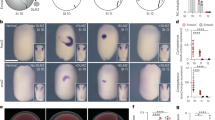Abstract
Temperature is a key factor in controlling the distribution of marine organisms and is particularly important at hydrothermal vents, where steep thermal gradients are present over a scale of centimetres1. The thermophilic worm Alvinella pompejana, which is found at the vents of the East Pacific Rise (2,500-m depth), has an unusually broad thermotolerance (20–80 °C) as an adult2,3, but we show here that the temperature range required by the developing embryo is very different from that tolerated by adults. Our results indicate that early embryos may disperse through cold abyssal water in a state of developmental arrest, completing their development only when they encounter water that is warm enough for their growth and survival.
This is a preview of subscription content, access via your institution
Access options
Subscribe to this journal
Receive 51 print issues and online access
$199.00 per year
only $3.90 per issue
Buy this article
- Purchase on Springer Link
- Instant access to full article PDF
Prices may be subject to local taxes which are calculated during checkout

Similar content being viewed by others
References
Edmond, J. M., Von Damm, K. L., McDuff, R. E. & Measures, C. I. Nature 297, 187–191 (1982).
Chevaldonné, P., Desbruyères, D. & Childress, J. J. Nature 359, 593–594 (1992).
Cary, C. S., Shank, T. & Stein, J. L. Nature 391, 545–546 (1998).
Young, C. M. & Tyler, P. A. Limnol. Oceanogr. 38, 178–181 (1993).
Mullineaux, L. S. & France, S. C. in Seafloor Hydrothermal Systems: Physical, Chemical, Biological and Geological Interactions (eds Humphris, S. E., Zierenberg, R. A., Mullineaux, L. S. & Thomson, R. E.) 408–424 (Am. Geophys. Un, Washington DC, 1995).
Marsh, A. G., Mullineaux, L. S., Young, C. M. & Manahan, D. T. Nature 411, 77–80 (2001).
Lutz, R. A., Jablonski, D., Rhoads, D. C. & Turner, R. D. Mar. Biol. 57, 127–133 (1980).
Zottoli, R. A. Proc. Biol. Soc. Wash. 96, 379–391 (1983).
Young, C. M. & Cameron, J. L. in Reproduction, Genetics and Distributions of Marine Organisms (eds Ryland, J. S. & Tyler, P. A.) 225–231 (Olsen & Olsen, Fredensborg, Denmark, 1989).
Author information
Authors and Affiliations
Corresponding author
Rights and permissions
About this article
Cite this article
Pradillon, F., Shillito, B., Young, C. et al. Developmental arrest in vent worm embryos. Nature 413, 698–699 (2001). https://doi.org/10.1038/35099674
Issue Date:
DOI: https://doi.org/10.1038/35099674
This article is cited by
-
Life-history traits of alvinocaridid shrimps inhabiting chemosynthetic ecosystems around Japan
Marine Biology (2023)
-
Evolutionary history of the p53 family DNA-binding domain: insights from an Alvinella pompejana homolog
Cell Death & Disease (2022)
-
Contrasting reproductive biology of two hydrothermal gastropods from the Mid-Atlantic Ridge: implications for resilience of vent communities
Marine Biology (2020)
-
Genetic connectivity from the Arctic to the Antarctic: Sclerolinum contortum and Nicomache lokii (Annelida) are both widespread in reducing environments
Scientific Reports (2018)
-
Structure Modify of High-pressure Chamber in Pressure-retaining Sampler for Deep-sea Sediment
Journal of The Institution of Engineers (India): Series C (2017)
Comments
By submitting a comment you agree to abide by our Terms and Community Guidelines. If you find something abusive or that does not comply with our terms or guidelines please flag it as inappropriate.



